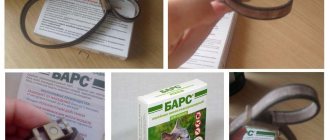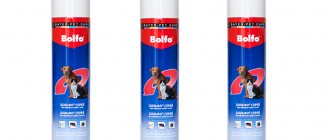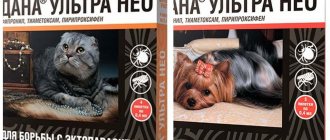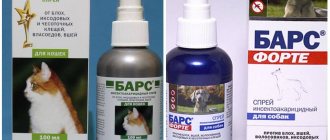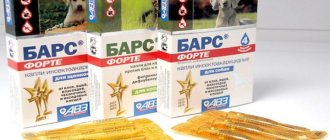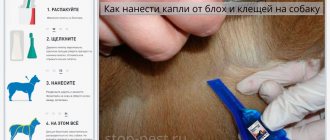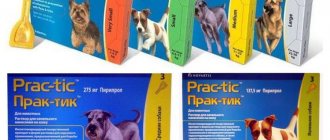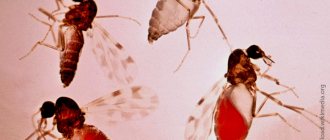French Frontline antiparasitic products are considered one of the best. They are often prescribed by veterinarians and recommended by breeders.
However, in recent years, the drugs have begun to be criticized. Some dog owners note a decrease in the effect, others indicate a weak effect, while others generally talk about frequent adverse reactions and mutagenic manifestations.
Is Frontline safe for dogs, how effective is it, is it worth buying this expensive drug, and are there any worthy analogues? We’ll look at it in this review.
Release forms and composition
The main advantage of Frontline is the abundance of types and forms of release. The drug is produced in 6 variations:
- Frontline Spot On. Classic drops on the withers against fleas and ticks. Contains 10% fipronil. Produced in 4 variations for dogs: marked S – from 2 to 10 kg (440 rubles), M – from 10 to 20 kg (475 rubles), L – from 20 to 40 kg (545 rubles), XL – from 40 to 60 kg (583 rubles).
- Frontline Combo. Also available in the form of drops on the withers, it has a similar effect. But in addition to fipronil (10 g), it additionally contains S-methoprene (9 g): this substance inhibits the growth of parasites. Therefore, the Combo variety eliminates insects at the stage of eggs and larvae. Release forms are similar to Frontline Spot On: S – 560 rubles, M – 640 rubles, L – 695 rubles, XL – 660 rubles.
- Frontline Tri-Act. Kills fleas, ticks and repels blood-sucking insects. Contains fipronil (6.76%) and repellent permethrin (50.48%). Available in 5 variations: on average 2-5 kg costs 550 rubles, 5.1-10 kg – 510 rubles, 10.1-20 kg – 580 rubles, 20.1-40 kg – 680 rubles. rub., for 40.1-60 kg – 700 rub.
- Frontline Spray. Used primarily to protect young dogs and bitches. Made with fipronil (0.25 g). A 100 ml bottle costs 940 rubles, a 250 ml bottle costs 1,580 rubles.
- Frontline NexgarD. Medicine (medicine) in the form of a chewable tablet with the taste of stewed beef. The active ingredient is afoxolaner (2.27%), effective against exoparasites. There are 4 forms for dogs: for 2-4 kg (RUB 1,450), for 4.1-10 kg (RUB 1,660), for 10.1-25 kg (RUB 1,804), for 25.1 -50 kg (RUB 2,015). Each package contains 3 tablets.
- Frontline Nexgard Spectra. A subspecies of the regular Nexgard. In addition to afoxolaner (1.87%), it contains milbemycin oxime (0.38%). Therefore, it has a combined effect: it helps against blood-sucking parasites and helminths. Produced in 5 variations for dogs weighing: 2-3.5 kg (RUB 1,530), 3.5-7.5 kg (RUB 1,700), 7.5-15 kg (RUB 1,900). ), 15-30 kg (2,300 rub.), 30-60 kg (2,600 rub.).
Front line combo
The drug is produced in the form of drops. Has an improved formula. It contains several active components - fipronil, S-methoprene. The latter substance has a detrimental effect on flea larvae and eggs, destroying their chitinous cover. Otherwise, all properties and rules of use are similar to the previous drug.
Frontline Combo against ticks, fleas for cats and dogs costs an average of 600 rubles. per pipette. Shelf life – 3 years from the date of manufacture. Should be stored away from direct sunlight.
Indications for use
All drugs in the Frontline series are prescribed to cure parasites and prevent their infection. So, they help from:
- fleas;
- lice eaters;
- ixodid ticks;
- scabies (sarcoptoid) mites – Spray, NexgarD and Spectra do not work against them;
- lice;
- mosquitoes
The Tri-Act form also has a repellent and insecticidal effect against dipterous insects: mosquitoes, burner flies, mosquitoes. And NexgarD Spectra destroys the larvae of heartworms and gastrointestinal nematodes: toxocara, hookworm, trichocephalosis.
Any medicine from Merial is indicated for:
- entomosis – diseases caused by insects;
- acaroses – pathologies that arose due to mites;
- otodectosis - ear scabies;
- allergic dermatitis caused by fleas (in complex therapy).
If, in addition to these conditions, there is a risk of contracting dirofilariasis, NexgarD Spectra is prescribed.
How often can drops and spray be used?
Frontline drops for cats should be used monthly. Only in this way can the active ingredient fipronil disrupt the life cycle of fleas and kill all ticks. The effect of the product can be observed for six weeks, but the risk of re-infection and the development of flea dermatitis appears after 4 weeks. You also need to remember that the effect of the Spot He solution stops after swimming, immersion in water, or after aggressive exposure to sunlight. But Spray and Combo are not afraid of weather surprises.
Some owners refuse to treat their animals monthly, citing the fact that fleas and ticks develop immunity to the drug. There is no scientific evidence for this claim. Difficulties in controlling fleas may be due to changing weather conditions or poor home hygiene. Effective control of parasites includes not only continuous year-round treatment of the animal, but also regular washing of bedding and mopping of floors.
Drug safety studies
The instructions indicate that, according to GOST 12.1.007-76, medicines from the Spot On, Tri-Act, Combo and Spray lines belong to the 3rd hazard class (moderately hazardous substances), and NexgarD and Spectra - to the 4th class ( low-hazard substances). These results are confirmed by research from the manufacturer.
For the experiment, 4 primary groups were formed. The first was not treated with medication, the second received the drug in a single dosage, the third in a three-fold dosage, and the fourth in a five-fold dosage. The condition of the animals was monitored using clinical tests, skin biopsy, and histological studies.
The results of the analyzes showed that there were no differences in the well-being and condition of the pets of different control groups.
Additionally, a similar analysis was carried out on puppies. It was found that in some kittens, the antiparasitic agent leads to increased discharge from the eyes and the formation of dandruff. But in general, children tolerate the medication well.
Today, the results of pharmacological research continue. Over the entire period of the program, Frontline has treated over 3 million animals of different ages, sizes and breeds. Only isolated cases of treatment regarding side effects were recorded. However, all of them were not directly related to the use of the drug - it could only influence the occurrence of negative reactions indirectly.
However, a number of breeders claim that the medication has a mutagenic effect. In particular, there have been cases of puppies being born with conjunctivitis and dermoids of the eyelids from parents who previously gave birth to healthy litters. These data have not been clinically confirmed, but they should be taken into account by nursery owners.
How to distinguish the original Frontline from a fake?
Frontline drops are sold in most countries around the world. Like any other effective drug, it is very often counterfeited. In order not to give away money for counterfeit goods, you need to pay attention to important details.
Firstly, even single doses of the product are sold in individual cardboard packaging. If the seller offers to purchase a separate plastic pipette (motivating this by the fact that in order to reduce the cost of the drug, the store ordered bulk packaging), then it is better to refuse the purchase. Secondly, the lot number and expiration date must be indicated on the box. In this case, the batch number must be duplicated on the plastic applicator. In each box you can find an insert with information about first aid for the animal (in case of an allergic reaction), instructions for use. The applicator itself is additionally sealed in plastic (to protect it from small children). There should be no additional stickers, inserts or holograms in the packaging.
The following information is indicated on the back of the applicator itself:
- ;
- product name and type;
- marked “for external veterinary use only”;
- concentration of active ingredient;
- amount of liquid in the pipette.
Frontline drugs are manufactured in France, but since they are packaged in accordance with the rules and regulations of the consumer countries, Russian versions may be marked “PCT”. The appearance of cardboard boxes from different batches may differ; in particular, manufacturers change the color design and photographs of cats.
How it works
The action of Frontline depends on the form of release. Thus, drops on the withers (Spot On, Tri-Act, Combo) and spray almost do not penetrate the body and do not enter the systemic bloodstream. After application, the active components spread over the entire surface of the skin, accumulate in the cells of the epidermis, hair follicles and sebaceous glands, from where they are released along with the secretion.
But drugs in the form of tablets (NexgarD and Spectra) work systemically. The active substances included in their composition are absorbed by the walls of the stomach and intestines, enter the systemic circulation and accumulate in the plasma. Their maximum concentration is observed in the body after 30 minutes or 2-4 hours, and the elimination period ranges from 1.5 days to a month (depending on the type of component).
The effects of the components vary depending on their type:
- Fipronil. It disrupts the transmission of nerve impulses in insects, leading to their paralysis and death. Included in Spot-On, Combo, Spray, Tri-Act.
- S-methoprene. Inhibits the growth of blood-sucking parasites by disrupting chitin synthesis and prevents insects from reaching sexual maturity. Contained in Combo.
- Permethrin. It has an insectoacaricidal (deadly) and repellent (repellent) effect. Used in Tri-Act.
- Afoxolaner. Blocks insect receptors and the transmission of nerve impulses, which causes paralysis and subsequent death. Active ingredient: NexgarD and Spectra.
- Milbemycin oxime. Works against all forms of nematode development, as well as heartworm larvae. Increases the permeability of cell membranes, which causes paralysis and death of helminths. Used in Spectrum.
The duration of the protective effect also varies among different forms:
- Spot It prevents infection by ticks for up to 35 days, fleas - 4-12 weeks;
- The combo works: up to 28 days against ixodid ticks, 4-12 weeks against other insects;
- The spray works: 3-5 weeks against ixodid ticks, 1-3 months against fleas;
- Three-Act destroys fleas within a day, and within two days – lice-eaters, sarcoptic and ixodid ticks, the preventive effect lasts 4-5 weeks, during this period it also repels mosquitoes, mosquitoes and burn flies;
- NexgarD begins to work half an hour after administration, destroys fleas in 6 hours, ticks in two days, remains effective for a month, gets rid of parasites before egg laying - this prevents re-infestation and the spread of insects in the house;
- Spectra is similar in action to NexgarD, only it gets rid of ticks 2 times faster - within 24 hours.
Skin parasites of cats
The most common and common in cats are:
- Fleas choose not only animals as victims, but also humans. Insects actively jump on the animal's skin and are easy to notice. More than 60 species of blood-sucking parasites carry over 200 diseases: anthrax, typhoid fever, salmonellosis, helminthiasis, and various fungal infections. Adult fleas do not live on the victim's body 24 hours a day. Having had enough, they leave the cat.
- Lice eaters are small wingless insects. They feed on particles of fur and epidermis, and blood. Like other ectoparasites, lice eaters force the cat to constantly scratch the skin until wounds appear. Damaged skin is easily attacked by pathogenic bacteria. When a cat is infected with a lice-eater, sleep and appetite are disrupted, immunity decreases, and allergies occur.
- Lice - when infested with lice, the animal behaves restlessly, scratches the skin, and loses hair. Lice are easy to spot. On your pet's light coat, black dots that look like dirt and dust are clearly visible - these are parasite excrement. In case of mass infection, the animal faces dermatitis and complete baldness. Lice are carried by helminth larvae.
- Ixodid ticks - attack cats in the warm season. These small insects feed on blood and grow greatly in size. A swollen tick can be noticed immediately. A cat's skin and fur are very sensitive, so the animal can easily shake off an unattached tick from its skin. In search of food, insects willingly move onto people. Ticks carry many diseases: viral encephalitis, typhus, tularemia, hemorrhagic fever, piroplasmosis, helminthiasis, etc.
- Scabies mites live on the skin of a cat, gnawing passages in the inner layer of the dermis. They feed on epithelial cells and lymph. From a sick animal the tick is transmitted to people.
- Sarcoptoid mites are the cause of scabies. The peculiarity of this form is the rapid baldness of the ears, belly and muzzle.
- Ear mites - attack the animal's hearing system. The cat shakes its head and tries to get its hind paw inside the ear. Dark brown crusts form in the ears, followed by pus. Without treatment, the parasites gradually penetrate through the inner ear into the brain, and the animal dies.
- Heartworms (dirofilaria) cause one of the most dangerous diseases, dirofilariasis. The helminth larvae enter the mouthparts of the mosquito with the blood of the infected creature, and with the next bite the parasites enter the body of the final victim. They live under the skin, in the muscles of internal organs. Parasites destroy the heart, lungs, and coronary vessels. Without treatment, the animal faces death.
Photo gallery: dangerous cat ectoparasites
Fleas are the most common skin parasites
Hairworm - the cause of focal baldness in cats
Cat lice are as common as fleas, although they are less well known.
Hungry and well-fed ticks are very different in appearance
Getting rid of ear mites is a long and expensive task.
Heartworm is the causative agent of dirofilariasis, spread by mosquitoes.
Instructions for use and dosage
The nuances of using Frontline depend on the specific type of drug.
Drop shape
Spot On, Tri Act or Combo is applied to dry, uninjured skin in two places: at the base of the back of the head and between the shoulder blades. To do this, fix the pet and squeeze the solution out of the pipette, spreading the fur.
If the dog has otodectosis, the solution is instilled in 4-6 drops into both ears, and the remainder is squeezed out of a pipette between the shoulder blades.
Dosages are selected by purchasing the drug for the appropriate size. If the dog weighs more than 60 kg or its weight is in borderline values, combine 2 pipettes, whose total volume will be as close as possible to the weight of the pet.
Drops are used in the following dosages. Spot On:
Combo:
Three-Act:
Spray Form
The spray is more convenient in terms of dosage selection. It is used like this:
- the treatment is carried out in the yard or in a ventilated area (with open windows and doors);
- pre-cover aquariums, remove cages with ornamental birds, move away from the hives;
- put a muzzle, a collar on the dog, or tighten the jaws with tape - they are not removed until the solution has completely dried, so that the pet does not lick the drug;
- The bottle with the spray is shaken and, holding it vertically, sprayed at a distance of 10-20 cm;
- apply the solution to the entire body of the dog in the direction against hair growth, lift the long hair with your hand;
- then close the animal’s eyes and nose and carefully spray the spray onto the chest and ears;
- Rub the product around the eyes and nose with your fingers.
Dosages for the Spray are as follows:
After applying drops or spray treatment, the pet is not bathed (with water or shampoo) for 48 hours. During this same period, they do not allow him to swim in bodies of water; they make sure that he does not run through puddles or roll around in mud or rotten meat.
Tablet form
Dogs usually eat the chewable tablets themselves. But if the dog refuses to eat them, the capsule can be given in 3 ways:
- disguise it in the stern;
- wrapped in a piece of delicacy: minced meat, cheese or butter;
- force-feed by opening the jaws and placing the pill on the root of the tongue.
Dosages for NexgarD:
Dosages for NexgarD Spectra:
Select tablets according to the weight of the animal and the appropriate labeling. If the dog weighs over 50 kg, combine 2 capsules with different contents of components that are most suitable for the pet’s weight. You cannot break the pills.
Make sure the pet swallows the tablet. If he spits it out or vomits soon after giving the medicine, he is fed again in the same dosage.
Frontline spray
The aerosol product is produced in bottles of 100; 250 ml.
The cost of a 100 ml bottle in September 2022 is 845 rubles.
The spray protects cats from ixodid ticks for 3 weeks, fleas - 6 weeks. The dogs will be free of ectoparasites for 5 and 12 weeks respectively. Dispense the drug with the number of presses on the spray head in accordance with the table:
| Live weight, kg | Number of clicks | |
| 100 ml | 250 ml | |
| 5 | 30 | 10 |
| 10 | 60 | 20 |
| 15 | 90 | 30 |
| 25 | 150 | 50 |
The table provides recommendations for treating pets with short hair. For long-haired dogs, the number of presses is doubled. To prevent a cat or dog from licking the insecticide, place a neck collar, muzzle, or tie the closed jaws with a rope while it dries. Avoid contact of the aerosol with the eyes. Problem areas are treated with your finger after wearing gloves.
The animal should not be allowed to get wet for two days after treatment. There are no restrictions on the weight and age of the animal. The aerosol is stored for 2 years at temperatures from 0 to 25 °C.
Contraindications and side effects
Merial products are prohibited from being given to:
- sick, recovering, weakened and exhausted animals;
- pets with hypersensitivity to the active ingredients of drugs;
- for puppies up to 8 weeks and weighing up to 2 kg, with the exception of a spray that can be used from the 3rd day of life;
- dogs with a perforated eardrum if ear treatment is planned;
- together with other insectoacaricidal drugs;
- Drops and spray should not be applied to wet, irritated or damaged skin.
In addition to these restrictions, take into account that both forms of NexgarD are prohibited for pets with severe liver and kidney disorders. And Spectra is not safe for collies, shelties and related breeds.
Puppy bitches can be given drugs, but they are treated under the supervision of a veterinarian.
Side effects are rare and go away on their own within 1-2 days. Possible:
- itching;
- hair loss;
- skin hyperemia;
- hypersalivation - increased salivation;
- neurological symptoms: anxiety and irritability (associated with the activation of insects in the first hours), excessive activity or, conversely, a depressed state;
- vomit.
If NexgarD or Spectra were used, peeling of the skin, erythrema, and drowsiness are also possible.
In case of overdose, in addition to these symptoms, muscle tremors and breathing problems may appear. And when using tablets, there is also a decrease in appetite and weight gain. Keep in mind that your pet may stagger when walking if you incorrectly calculated the dose of Spectra.
Pros and cons of drugs
The manufacturer has developed 3 types of ectoparasite product for cats. Each form of the product has its own positive and negative properties. To choose the right medicine for your pet, you need to contact a specialist who will assess the cat’s condition and recommend the most effective and safe type of drug for him. The table shows all the pros and cons of Frontline brand antiparasitic agents:
| Name of the drug | Advantages | Flaws |
| Spot He | Thanks to the pipette, the substance only gets on the pet’s skin, does not splash or stain your hands. A reasonable price and the ability to purchase in veterinary pharmacies make the drops accessible to most cat owners. The solution destroys ear mites, therefore it is effective in the treatment of otodectosis. | The solution is poured into small volume pipettes; if some of the product spills, the remaining will not be enough to effectively combat parasites. |
| Combo | These drops are also convenient to apply to the animal's skin. They have a more pronounced effect, destroying not only adults, but also eggs and larvae of parasitic arthropods. Reduce itching caused by numerous bites. | The liquid cannot be used if the kitten weighs less than 1 kg. |
| Spray | The bottle has a large volume. The spray package lasts for a long time with regular use. Spraying allows you to distribute the substance throughout the body. The spray can be used even to treat very small kittens and pregnant females. Resistance to moisture allows you to walk and bathe pets 48 hours after treatment. | High risk of inhalation of the substance by humans and animals. Danger of allergic reactions. Cats often don't like liquid getting on their fur. |
Analogues of the drug
The selection of similar medications depends on which particular release form of Frontline needs to be replaced. The following analogues are produced:
| Name | What is the difference | Prices |
| Insectoacaricidal spray Bars | Made with fipronil. Do not use on pregnant and lactating females, as well as puppies. There is an improved formula “Forte” with diflubenzuron (0.1%) - the substance accumulates in the sebaceous glands and prolongs the effect of the drug. | Bars Forte – 330 rub. for a 100 ml bottle, regular: 260 rub. – for 100 ml, 375 rub. for 200 ml. |
| Hartz UltraGuard Plus Flea and Tick Spray for Dogs | The drug is in the form of a spray based on tetrachlorvinphos (1.08%) and methoprene (0.07%). Shorter duration: prevents infection by adult insects for up to 7 days, eggs – up to 4 weeks. Prohibited for puppies up to 1.5 months. | RUB 1,050 |
| Bravecto | Synonymous with Frontline Nexgard. Available in 2 types: drops on the withers and tablets. Works against exoparasites. Lasts longer - up to 12 weeks. | 800 – 1,500 rub. depending on the release form and dosage. |
| Reksolin Plus | Analogous to Frontline Spot on and Combo. The composition is similar in the presence of fipronil and methoprene. | 400-600 rub. depending on the species and the weight of the animal. |
| Hartz Ultra Guard drops | The action is similar to Frontline Three Act. However, they contain another active ingredient – phenothrin (85.7%). Allergic reactions, vomiting, and muscle tremors are possible. | 740 rub. |
| Stronghold | Synonymous with Spot On and Combo. It has a wider spectrum of action: kills fleas, ticks, roundworms and heartworms. | 1,500 per pack of 3 pipettes. |
| Advocate | Another drops of complex action. Helps against fleas and ticks. However, they are not effective against the parasites that cause ear scabies. But they work against helminths. | 1,200 rub. |
Recommendations when choosing a product
When choosing a suitable anti-tick product, you need to focus on the dog’s health, its weight, the presence of allergies to the components included in the composition and affordability.
Table: advantages of different Frontline tools
| Name of the drug | In what cases is it suitable? | Price |
| Frontline Nexgard tablets |
| A pack of three costs about 1,500 rubles, which means protection for a month will cost 500 rubles. |
| Combo |
| One pipette (valid for 1 month) costs from 600 to 1 thousand rubles, depending on the type of drug according to the “weight category” of the pet. |
| Tri-Act |
| |
| Spot He |
| |
| Spray |
|
Product consumption is only 3–6 ml per kg of animal weight. |
Among the Frontline products, you can easily choose the drug that is suitable for your four-legged friend. The main thing is to take into account the individual characteristics of the pet. Before using antiparasitic drugs, do not be lazy to consult with a veterinarian and carefully study the background information. The effectiveness and safety of products usually depends on strict adherence to instructions.
Owner reviews
Bonnie-Blue: “Frontline drops were recommended to me by both the vets and a volunteer friend who helps homeless animals. I treated my cat with them for several years and was satisfied. But last year I also got a dachshund. The drops don't help her at all. Moreover, allergies popped up. I took the drug at the clinic, so counterfeits are excluded.”
CHOYU: “My two dogs spend the summer at the dacha, where there is a sea of ticks. I give them Spectra and no problems: insects only allow themselves to crawl on animals.”
Katushka: “We came out of town for the weekend. While combing, I discovered fleas on my Spitz dogs. The choice of medication has become a problem because... I had a recently whelped female with two-week-old kittens. I decided that it was better to use Frontline Spray. It smells unpleasant, but the fleas disappeared on the third day. And all the pets, including babies, underwent the procedure without any problems.”
Advantages
Frontline for fleas
Medicinal drops for fleas are certified in Russia and have passed clinical trials. Reviews of Frontline drops can be read on the manufacturer’s website or on forums on the Internet. Customer opinions are mostly positive and they talk about the advantages of this drug over other similar products, namely:
- one of the most effective drugs with 98–100% results;
- it is safe for humans and beloved pets even if the product is ingested, since there are no side effects;
- Frontline does not cause dermatitis or allergies in cats and is used to treat these diseases;
- has a very wide range of action, effective even in the fight against scabies mites;
- a simple method of use by applying it to the withers of the animal;
- it works even after four to six baths using special detergents, and the protection is quickly restored;
- long residual life;
- convenient when treating several pets at the same time: although the product can get into the stomach of kittens or puppies while biting or licking each other, with Frontline you don’t have to worry about the health and condition of your beloved pets;
- It is allowed to be used for nursing and pregnant cats, since the drops do not enter the bloodstream and cannot harm the developing fetus, and the active substance does not penetrate into milk.
Answers to frequently asked questions
Recently the dog was treated with another antiparasitic agent. How quickly can Frontline be applied?
There should be at least a month between the use of different drugs. Carefully read the instructions for the previously used drug - it should contain instructions.
My pet weighs less than 2 kg. How should I treat him for fleas and ticks?
In such cases, it is recommended to use a spray form. The remaining types of drugs are designed for dogs weighing from 2 kg.
I am pregnant. Can I treat my dogs with medication myself?
Information about the dangers of Frontline for people, incl. during pregnancy, no. But it is better to ask another person to perform the procedure. If this is not possible, use gloves and then wash your hands thoroughly up to the elbows with soap.
I treated the dog with medicine, but soon found a tick on him. What to do?
The parasite must be removed quickly and carefully.
Why choose Frontline products
Frontline medications are produced by Merial, which is the largest manufacturer of veterinary products for various purposes:
- antiparasitic agents against fleas, ticks and worms;
- vaccines and therapeutic preparations for cats, dogs, horses, pigs, birds.
Experience is more than 15 years. The share of the global veterinary products market is more than 15%. The range is designed in such a way that every dog owner can find a solution to their pet’s problems in different situations.
Among the Frontline products there is one that is right for your dog
You can choose a product from the Frontline line even under the following conditions:
- the dog suffers from allergic reactions to most drugs;
- the dog is aggressive (it is difficult to get close and handle);
- the dog weighs little (less than 1 kg);
- this is a newborn puppy;
- the dog is constantly in contact with water (this reduces the effectiveness of many flea and tick protection products).
Trusted by pet owners all over the world. Since the existence of Frontline products, they have carried out over 1.5 billion treatments against ticks and fleas. This means that every second Frontline is applied to at least three pets!
conclusions
The drugs are generally good products that will destroy the parasites that have already settled on your pet and prevent subsequent infestations. The only thing is that it is better not to take Spectra, but to independently select an anthelmintic with a wider spectrum of action: Canikquantel, Drontal, Profender, Milbemax, Alben S, etc.
For several years I prescribed Frontline without fear. But lately there are a few things to consider:
- counterfeits have become more frequent;
- the clinic is often contacted about negative reactions after using drugs;
- Entomoses and acaroses are becoming increasingly common in animals treated with drugs from Merial.
It is also impossible to ignore the observations of breeders who note mutagenic effects in litters of healthy purebred dogs and even mongrels, in which the risk of recessive genes and associated hereditary diseases is minimal. Although no research has been done on this, keep this point in mind.
Frontline drops, spray and tablets are controversial drugs. In most cases, they work well and do not affect the dogs' health. But it may cause side effects or may not work in some animals. Therefore, there is a reason to choose another medication: Bravecto, Bars, Hartz, Rexolin.
Interesting read: What kind of dog to have in an apartment
Mechanism of action
After use, the active substance does not penetrate into the blood, but is distributed throughout the skin and hair. The drug has a contact effect - parasites die when they come into contact with Frontline microparticles. After the product gets on the skin, the active agents fipronil and S-methoprene, together with sebum, are distributed over the surface, enveloping the hairs and covering every millimeter of the cat’s body with an invisible veil.
Frontline acts contactally, destroying only parasites
Interaction with other drugs
The drug developers point out that the simultaneous use of Frontline products with other insectoacaricides is inadmissible. This can lead to mutual reinforcement of toxicity and poisoning of the pet.
Interaction of the drug with antibiotics and other strong drugs is also undesirable. If the time to treat your cat for parasites has come when the animal is being treated with some kind of medication, then you should consult a veterinarian. He will be able to tell you exactly whether Frontline can be combined with the specific drug being used.
Which is better: Frontline or Stronghold for cats?
This issue is being discussed in many forums for animal lovers, and the participants in the dispute are still very far from reaching a consensus.
But! We would like to remind you that these two drugs are not even analogues: in Frontline the “first fiddle” is played by fipronil, while in Stronghold it is selamectin.
Many breeders insist that Frontline is better because fipronil is less toxic. There is a considerable amount of truth in this, but still we should not forget about individual tolerance/intolerance to the components of the medicine.
We also recommend that you always consult with your veterinarian before using any of these products. Since the concepts of “better” or “worse” are very subjective.
The veterinarian must decide on the advisability of using one or more of the drug, based on how well the cat’s body tolerates the drug.
Properties
Frontline Combo refers to combined insectoacaricidal drugs with contact action.
Frontline Combo is active against:
- fleas (mature and preimaginal stages of development) Ctenocephalides spp.;
- lice eaters Felicola subrostratus, Trichodectes canis;
- ixodid ticks (all developmental phases) Dermacentor variabilis, Rhipicephalus sanguineus, Ixodes scapularis, Ixodes ricinus, Ixodes holocyclus, Haemaphysalis longicornis, Haemaphysalis flava, Haemaphysalis campanulata, Haemaphysalis leachi, Amblyomma americanum;
- mosquitoes Aedes aegypti;
- sarcoptoid mites Sarcoptes scabiei var. canis.
